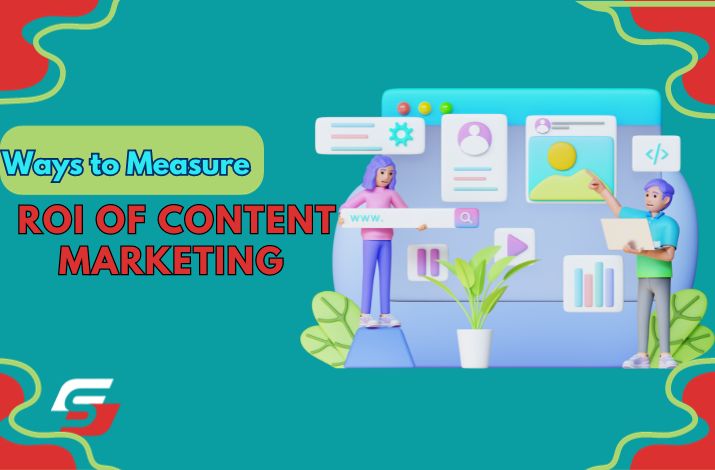As an effective tool for engaging and converting consumers, content marketing has become a crucial component of contemporary corporate strategies. It might be difficult to determine the return on investment (ROI) of your content marketing initiatives, though.
Content marketing is typically viewed as a long-term investment that can be challenging to quantify, in contrast to traditional marketing approaches where ROI may be easier to determine. In this blog post, we have mentioned the super easy ways to measure the ROI of content marketing campaigns.
Ways to Measure the ROI of Content Marketing:
In the under section, we have mentioned the ways to measure the ROI of content marketing campaigns:
Traffic Metrics
Start with the basics to determine the return on investment of your content marketing initiatives. Assessing website traffic analytics is a widely used and essential method for determining the effectiveness of your content. Key metrics to consider include:
- Use tools like Google Analytics to track the overall volume of visitors to your website. You can break this down into new visitors and returning visitors.
- Monitor the number of page views, especially for the content you’ve produced, which can help identify the popular part.
- A high bounce rate can indicate that your content is not resonating with visitors. Reducing the bounce rate can lead to more engaged users.
- A longer average time on the page suggests that visitors are finding your content valuable and are engaging with it.
Conversion Metrics
Traffic alone doesn’t necessarily indicate a successful content marketing campaign. To measure the real impact, you need to track how well your content converts visitors into leads or customers. Key conversion metrics include:
- Conversion Rate: This is the percentage of website visitors who take a desired action, such as signing up for a newsletter, downloading an eBook, or making a purchase.
- Lead Generation: Track the number of leads generated through your content. Email subscribers, contact form fills, and other activities that show interest in your goods or services can all be considered leads.
- Sales: In the end, the money you make from your content marketing efforts may be used to calculate their return on investment. Link content to actual sales through attribution models or tracking conversions to specific blog pieces.

Customer Retention and Loyalty
Content marketing is not just about acquiring new customers; it’s also about retaining and nurturing existing ones. Loyal customers are more likely to make repeat purchases and become brand advocates. Monitor metrics related to customer retention and loyalty, such as:
- The churn rate measures the percentage of customers who stop doing business with you. Content can play a role in reducing churn by providing value and relevant information to existing customers.
- Content can increase CLV by keeping customers engaged and informed. CLV is a critical metric for understanding the long-term impact of your content marketing efforts.
- Happy customers are more likely to refer friends and write positive reviews. Tracking these metrics can help gauge customer satisfaction and the impact of your content on referrals and reviews.
SEO Performance
Search engine optimization (SEO) and content marketing are closely related. The exposure and search engine rankings of your website can be raised by producing high-quality content. Monitor SEO metrics to measure content effectiveness:
- Track your website’s rankings for relevant keywords in search engine results pages (SERPs). Improved rankings can lead to more organic traffic.
- Measure the number of visitors who come to your website through organic search. An increase in organic traffic can be attributed to successful content marketing efforts.
- High-quality content often attracts backlinks from other websites, which can positively impact your site’s authority and SEO rankings.

Social Engagement and Shares
Social media shares of your content are more likely to occur when it speaks to your audience. Metrics measuring social engagement can reveal information about the influence and reach of your content:
- Count the number of times your content is shared on social media platforms like Facebook, Twitter, LinkedIn, and Instagram.
- Analyze likes, comments, and click-through rates on social media posts that link to your content.
- Monitor the growth of your social media following, as engaging content can attract new followers who may become leads or customers in the future.
Customer Feedback and Surveys
Don’t underestimate the value of qualitative data in measuring content marketing ROI. Collecting feedback from your customers and surveying your audience can provide valuable insights into the impact of your content. Ask questions related to how content influenced their purchasing decisions and satisfaction levels.
Read Also: Top Digital Marketing Strategies for the Education Industry
Content Attribution Models
Content marketing often involves multiple touchpoints with a potential customer before they convert. Attribution models help you understand which content pieces or channels contributed most significantly to conversions. Common attribution models include:
- First-Touch Attribution: Credits the first interaction a customer had with your content for the conversion.
- Last-Touch Attribution: Credits the last interaction before conversion.
- Multi-Touch Attribution: Considers all the touchpoints along the customer journey.
Consider using attribution modeling tools or features available in marketing analytics platforms to gain a more accurate understanding of your content’s contribution to conversions.
Customer Segmentation
Segmenting your audience can help you better measure the ROI of content marketing by understanding which content is most effective for different customer groups. Segment your audience based on demographics, behavior, and engagement patterns, and then analyze how each segment responds to your content.

A/B Testing
A/B testing, or split testing, involves creating two versions of content with slight variations and comparing their performance. You can find out which elements result in higher conversion rates and return on investment by testing various headlines, graphics, calls to action, and content formats.
Benefit-Cost Analysis
You must weigh the costs and advantages of content creation in order to determine the precise return on investment of your marketing operations. Compare the revenue from content-related sales and conversions to the costs associated with producing and promoting content.
Conclusion
Analyzing the return on investment (ROI) of content marketing campaigns is crucial to determining the efficacy of your marketing strategy, even if it may not be as straightforward as measuring the ROI of a paid advertising campaign. You may have a thorough grasp of how your content marketing initiatives are supporting your company objectives by taking into account both quantitative and qualitative data.
It’s important to remember that, over time, authority, trust, and brand awareness are often developed as a result of content marketing. Use the information gathered from these KPIs to inform future iterations of your content strategy and ensure that your company’s content marketing efforts yield a lucrative return on investment.


